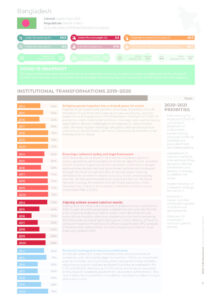Nutrition situation
Under five stunting (%)
30.8
Under five overweight (%)
2.2
Anaemia in women 15-49 years (%)
39.9
Under five wasting (%)
8.4
Low birth weight (%)
27.8
0 to 5-month-old exclusive breastfeeding (%)
65
Adolescent overweight (%)
Male: 8.5
/ Female: 8.4
Adult overweight (%)
Male: 16.3
/ Female: 17.8
Adult obesity (%)
Male: 2.4
/ Female: 5.2
Adult diabetes (%)
Male: 10.3
/ Female: 9.3
COVID-19 snapshot
The Government has taken several initiatives to respond to the crisis including a report on determining the impact of COVID-19 on nutrition and a projection of the possible malnutrition burden in any post COVID-19 period in Bangladesh.
Institutional transformations 2019-2020
Bringing people together into a shared space for action
Regular multi-stakeholder platform meetings chaired by the SUN Movement Focal Point are organised to discuss country nutrition responses and engagement of SUN platforms. During the COVID-19 pandemic, multi-stakeholder platform meetings were, and are being, organised to discuss challenges and measures to overcome the crisis. Similarly, regular meetings take place with various nutrition committees and platforms. All these committees and platforms are multisectoral in nature.Ensuring a coherent policy and legal framework
SUN Networks are involved in formulation of policies, plans of action, guidelines and strategies on nutrition-specific and -sensitive sectors. A policy mapping exercise has been conducted to analyse and evaluate relevant sectoral government policies and strategies through the food and gender lens. A concept paper is being developed for another multisectoral policy review and mapping exercise. All relevant networks have supported the Sun Business Network Strategy formulation and the implementation of the National Plan of Action for Nutrition 2 (NPAN2) and the Country Investment Plan 2 (CIP2).Aligning actions around common results
Twenty-two ministries identified and included nutrition activities in their 10-year and annual sectoral workplans in line with the NPAN2. A set of priority indicators with activities were identified for subnational level nutrition planning, implementation and monitoring. SUN Networks provided technical support to the Ministry of Food to conduct Integrated Food Security Phase Classification (IPC) analysis of food security and nutrition as well as mapping of chronic food insecurity zones in 2019.Financial tracking and resource mobilisation
All relevant plans are costed. Ministries have developed annual workplans with allocated budget for nutrition. CIP2 is an investment plan on nutrition-sensitive food systems designed to help mobilise resources to support policies and priority actions as outlined in the CIP2 and NPAN2. Monitoring of CIP2 shows the financial execution of the projects funded by government and donor commitment. This tool enables the Government to mobilise resources to reduce hunger and malnutrition.2020-2021 Priorities
- Determining the impact of COVID-19 on nutrition: projection of malnutrition burden during and post COVID-19. Developing a policy brief with recommendations.
- Assessment of nutrition-sensitive interventions of key sectors to identify bottlenecks and develop a strategy to address the issues.
- Implementation of a research strategy for nutrition.
- Establish a robust nutrition information system and showcase good practice.
- Advocacy for investing in nutrition-specific sectors.
Download

